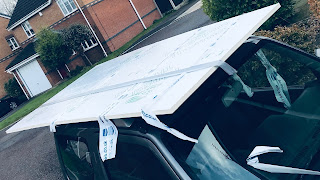The Airbus A320 this last week became the best-selling jet-airliner ever, though it nearly didn't happen at all. Though the first jet airliner was developed in the UK in the 1950s, manufacturers in the USA dominated the market in the 1960s by taking advantage of the fragmentation of the market in Europe. Only when the British, French, Germans, Dutch and Spanish combined their efforts in the A300 (the first wide-body twin) did it literally take off.
From the outset then, the Airbus story has been one of moving parts around to tally with the expertise located elsewhere. In a very modest way we've replicated that today: the top-end of the flying phone-box being transported on the roof-rack of a Suzuki Jimny 200 miles south to one of the team-members south of Bristol. Here ~ all being well ~ the avionics controlling the motors are to be wired up so that they can be bench-tested with the propellers in place.
We're also offered the expertise of drone-builders Vulcan (http://vulcanuav.com) for fine-tuning the rig for the purposes of control and stability.
So things are finally looking up... literally.






